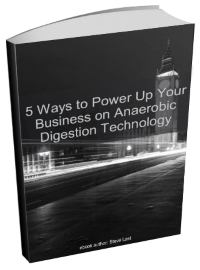 For our Anaerobic Digestion Technology Section, we have included the following pages:
For our Anaerobic Digestion Technology Section, we have included the following pages:
Anaerobic Digestion System Innovations
Anaerobic Digestion of Biomass
Anaerobic Digestion of Sludge
Two Stage Anaerobic Digestion
High Solids Anaerobic Digestion
Anaerobic digestion technology refers to the development of systems that are based upon the consumption of organic materials (usually considered to be waste), being acted on by nature's micro-organisms when exposed in an environment where oxygen is unavailable, to make energy, and other useful solid and liquid by-products.
Anaerobic Digestion and Biogas Plant Technology
The biogas market is probably unique in that it has two separate strands of technological development that are progressing side by side, but with little technical cross-over.
The two parts of this market that are being referred to here is the dichotomy of approach, between the developing nations and the industrialized world. In this article we will explain the differences, and end with a list of biogas technologies in the main biogas plant types in each sphere:
Biogas Technology in the Industrialized World
In industrialized nations, the anaerobic digestion market is about both the digestion of crops and the digesting, treating and sanitizing of wastes.
Comparatively large biogas installations for communities of several thousand in a population are typical. The plants are “high tech” in their design, and always instrumented, monitored in real-time and automated. It would be very rare for a “western” AD plant not to have a SCADA (supervisory control and data acquisition) system, at its core providing instantaneous status reporting on plant variables, and most can be adjusted by the operator remotely.
“Western biogas energy production systems are built to long design lives, 15 to 20 years is not uncommon. They also have unique business plans to provide a multitude of end products, from simple power generation using a gas engine, to upgrading systems which provide high-quality compressed gas which is in every way equivalent to natural gas (CNG) and can be mixed with it and delivered through the local gas grid as biomethane.
Biogas Technology in the Industrializing Nations and Remote Rural Regions
 The plants built using anaerobic digestion technology in the industrializing nations and the “low economy” off-grid rural regions, are by comparison much smaller and “low tech”. What they lack in size, they make up for in sheer numbers.
The plants built using anaerobic digestion technology in the industrializing nations and the “low economy” off-grid rural regions, are by comparison much smaller and “low tech”. What they lack in size, they make up for in sheer numbers.
They are almost without exception manually operated without any electrical power needed to operate them.
The “industry” is largely “craft-based”, and the designs used are often tailored to the available local skills and materials, geological conditions, and climate.
Click for a free book based upon the contents of this page!Rural Digesters
Operating the original types of buried rural digesters is a labour-intensive activity. But it is worthwhile. The purpose is usually to provide biogas for cooking on the premises where it is made or do so within a group of a few houses. They do not normally feature any electronic monitoring at all, let alone computerized controls, and none are thought to use SCADA systems.
These two anaerobic digestion plant technologies are so different that it is necessary to discuss the two groups of technologies separately:
1. Industrializing Nations
The following are the main biogas plant types being built in the industrializing nations. Don't be put off by the small scale of these installations. The biogas movement is very important due to the massive numbers of these systems which are now being built globally. Shera numbers of biogas plants are becoming so large that if a calculation was made of the energy produced from anaerobic digestion in the small and simple digesters worldwide, they may eclipse the energy output of those much larger AD plants in the “western world” in many industrializing nations.
a) Wet Digestion Technology
Wet digestion technology is where the substrates either start out as a pumpable slurry with their main constituents being water or is made into a pumpable mixture
i) Fixed-dome Plants
Fixed-dome Biogas Plants have rigid domes, usually constructed from stone blocks, or bricks. They are usually built below ground for summer and winter warmth, with the additional benefit that the curved domed gas-holding roof thrust is restrained within the surrounding soil.
They are most often sized for one household or small community, village, hospital, or a co-operative of farms. Their size is limited by the feasible span of the arched dome, and this is usually linked to the ability of the local constructors to avoid gas leaks.
ii) Floating-drum Type Plants
Floating-drum Type Plants unsurprisingly feature an upturned drum-shaped gas collector that floats on the surface of the digester liquid. They are set up in such a way that they rise and fall to accommodate the biogas as it is produced.
Usually smaller than fixed dome type AD plants there are many variants on the design, including guide rails to help them rise and fall without sticking against the walls. Similar biogas product applications apply as for fixed-dome reactors (gas for cooking and a gas mantle for light) “fixed dome” plants, above.
iii) Polyethylene Tube Digesters and Balloon Digesters
Polyethylene tube digesters and balloon digesters are poor relations to fixed and floating drum reactor technology. A plethora of designs are available, but by the time we get down the list to this point, the design life may be as low as 2 to 5 years.
This list is not exhaustive, and there are other plant technologies used in the “eastern nations”. These can best be subscribed as combinations and hybrids of the above. Some make good use of local geological ground conditions (for example plants tailored to ditch profiles depending on the slope stability of the local soils), and others make use of uncommon local expertise (e.g. in some localities the locals hold good ferrocement construction skills, and therefore use that material extensively).
2. Industrialized Nations (“the West” for want of a better description)
a) Wet Digestion Technology
Most anaerobic digestion plants built in the developed world are wet digesters. Most are also continuous process designs, and within the “west's” “Wet AD” classification there are a large number of technological features. Biogas is usually stored in gas holders which are fixed around the edges onto the rim of the mostly-circular digester tanks.
b) Dry Digestion Technology
In the industrialized nations there is increasing adoption of dry digestion. Dry digestion is not documented as being used in the industrializing world, so we did not give it a section heading of its own, earlier in this article.
Dry digestion is only possible for digestate substrates (usually those with high fibre content) which stand on their own, with near vertical edges when stored and stockpiled. In this type of plant, the wastes are driven-in with a mobile plant such as a front-end loader and deposited.
The waste may be mixed with seeding sludge, and/or sprinkled with a culture of micro-organisms emanating from the process itself, after the doors have been closed and the air left, has been de-oxygenated.
These facilities can look almost identical to in-vessel composting facilities, at times.
We hope that this has provided our readers with a useful overview of current anaerobic digestion and biogas plant technology.
Trends in the Application of Anaerobic Digestion Technology
This process leads to the production of biogas energy, and most of the systems built to date have used the gas they produce in a generator, to provide power, heating, and lighting.
However, as AD technologies become more sophisticated we confidently predict that the biogas methane will be used as a chemical feedstock for refinery product production, including fuels.
In fact, as other writers have pointed out, methane can be used to fuel existing refineries to provide all the plastics and similar products that fossil fuel-based oil provides today.
There is much evidence that the value to the biogas plant operator of the products will continue to rise, and an example of this is that new technology for the use of membranes for biogas upgrading (separating methane and CO2) allows not only the methane to be sold but also the CO2 which is an impurity within biogas.
The digestate output of these technologies has from the start used in the production of fertilizer for farming, but new uses will also be found for this, as well. It is already being dried, using otherwise wasted CHP energy, making a product which is light and unlike liquid digestate, transportable through the normal distribution channels.
The Revival of Anaerobic Digestion Process Technology
This technology has been in use for some time but the current global environmental challenges have now made people appreciate its importance for the first time in the modern era. This technology can be seen as the most effective way of managing household wastes, and is an appropriate technology in society's toolbox, for the avoidance of excessive greenhouse gases in the atmosphere.
“Different countries continue to give appropriate incentives to individuals and institutions to build this kind of renewable energy resource. For general guidance a digester with 1M3 of gas can provide cooking heat for a household of 4 to 6 members per day (3 meals). The biomass required for such a digester can be supplied by 2 cows. The actual set up of the digester has a container in which the slurry is put and a scrubber to minimize the levels of carbon dioxide in the biogas.”



Interesting page. You may like to know that biogas is successfully used for heating and electricity generation at a range of sites around Australia. Enhar assists clients with feasibility studies both technical and financial, and project implementation.
Good writing but I still don’t know how to make some basic decisions. Has someone written a step by step process technology selection guide? This is the difficulty for me so I can make some progress on my project.
Isn’t it fact that this tech anaerobic digestion, which I think is just another word for biogas, will never be as efficient in energy conversion as gasification?
Great article. I firmly believe the salvation of the planet will come from natural things which man helps to make better with technology. Its simple, do research, find out how nature works, make nature better with minimum impact. Not like fracking, that’s interfering with nature which we do not know how it works. Heck, we only just discovered it was there man.. Who knows what goes on down there miles underground?
I like this site because so much useful material is on here : D. The tech is also on sale in Mexico, for the very high power biogas outputting.
Hi. We have An anaerobic digester that produces megawAtt energy. But we don’t know that best balance of substrate to feed the digester.
Technicians have identified that we currently have ammonia poisoning. I don’t know how to fix that either
I think that you need an experienced biogas plant operator to look at your digester. Where is the digester? If in the UK I may be able to suggest a suitable person who might act as your troubleshooter. Use the form on our Contact Us page to contact me. What pH are you running the digester at? Ammonia inhibition is sensitive to pH so pH adjustment may be needed, but the solution probably needs more than that, and studying in detail. Sounds like you need expert advice.
No. I don’t know of any emails from you. The Contact Form should be working.
Are you still having problems? I ran a thermophylic anerobic digester site for two years and it worked great. Had six digesters each one holding 22,500 gallons each. Let me know if you still need advice.